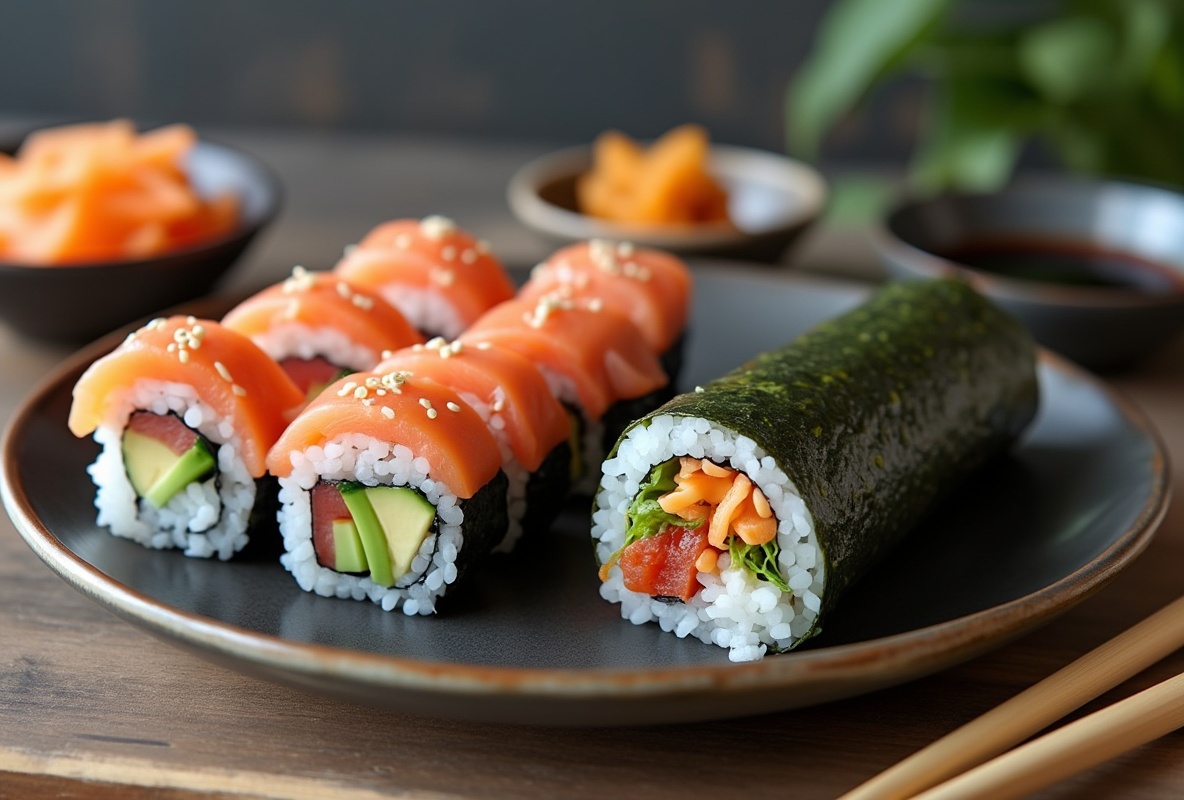The Basics: Understanding Sushi Rolls and Sushi Burritos
When it comes to the delightful debate of Sushi Roll vs Sushi Burrito, the key lies in appreciating both their unique qualities. A sushi roll, with its elegant and traditional charm, offers bite-sized pieces of rice and seafood wrapped in nori. Conversely, the sushi burrito combines boldness and convenience, rolling ingredients in a larger, handheld form. Both have their distinct place in the culinary world, and understanding the basics can help us appreciate what makes each special. Let's dive in and explore these delicious creations!
A Brief History of Sushi: From Classic Rolls to Innovative Burritos
When we think about the vibrant world of sushi, the journey from traditional sushi rolls to the creative sushi burrito is fascinating. Originally, sushi started as a way of preserving fish in fermented rice, a method known in Southeast Asia thousands of years ago. Over time, this evolved into nigirizushi during the Edo period in Japan—a more familiar form where fresh fish is pressed over compacted rice.
Now, let's fast forward to the culinary innovation of the sushi burrito. This exciting twist began gaining popularity in the early 2000s, especially in urban areas of the United States. The trend was partly driven by the increasing demand for convenient, on-the-go meals that still offer the authentic flavors of sushi.
The sushi burrito creatively combines the essence of traditional sushi with the practicality of a burrito. It wraps a larger variety of ingredients in a nori sheet, echoing both the visual appeal and tastes of sushi rolls in a bold, new form. The sushi burrito has quickly captured hearts due to its playful spirit, turning the tables on traditional sushi while still respecting its rich cultural roots.
Ingredients Showdown: Sushi Roll vs Sushi Burrito
When it comes to the battle between a sushi roll and a sushi burrito, the ingredients play a starring role. Let's dive into this delicious showdown. Sushi rolls are small yet mighty, often featuring a harmonious blend of vinegared rice, fresh fish or seafood, and vibrant vegetables like cucumber or avocado. They're delicately wrapped in a thin sheet of nori (seaweed). This classic preparation allows for intricate combinations of flavors that dance on the palate.
On the other hand, sushi burritos take these beloved ingredients and give them a modern twist. Imagine a sushi roll on steroids — bigger, bolder, and packed with more fillings. In a sushi burrito, you'll find not only the traditional components but also adventurous additions like spicy mayo, tempura bits, or even crispy chicken. Wrapped in nori but constructed more like a burrito, this version is perfect for those who want to savor the essence of sushi while on the go. Between the traditional charm of sushi rolls and the innovative appeal of sushi burritos, there's something for everyone in the sushi realm. Discover unique culinary fusions here.
Preparation Techniques: Crafting the Perfect Roll and Burrito
Creating sushi rolls and sushi burritos is a true culinary art. The process starts with the perfect rice preparation. Sushi rice must be sticky and seasoned with the right balance of vinegar, sugar, and salt. For a traditional sushi roll, a bamboo mat is essential. It helps in rolling the ingredients tightly into a cylinder. The ingredients are placed on a sheet of nori, and with careful rolling, you achieve that iconic sushi roll shape.
When it comes to sushi burritos, the process takes a delightful twist. Here, the concept of “bigger is better” holds true. Instead of delicate rolls, larger portions of rice and fillings are used. Ingredients like fresh fish, vegetables, and even fruits are spread across a larger nori sheet, and it’s all rolled into a hearty, handheld feast. This technique balances the art of rolling with a casual, more relaxed approach—making sushi burritos, not just innovative, but also satisfying in both texture and taste.
The difference in preparation between the two can change the dining experience entirely, making sushi burritos a playful twist on traditional sushi making.
Experience the Difference: Taste and Texture Comparisons
When it comes to taste and texture, sushi burritos offer a delightful twist on traditional sushi rolls. Imagine biting into a sushi roll—it's compact, delicate, and each piece is a small bundle of texture and flavor harmony. You get the classic combination of vinegared rice, fresh fish, and crispy seaweed, often paired with a hint of wasabi or a slice of pickled ginger. Each bite is a perfectly balanced experience.
On the other hand, a sushi burrito is like an explosion of flavors. It's larger, heartier, and often packed with a diverse array of ingredients. Think of the same sushi elements but amped up with additional veggies, sauces, and even unconventional fillers like grilled chicken or tempura shrimp. Explore exciting grilled chicken ideas here. The texture is a mix of crunchy and soft, thanks to the abundance of fresh ingredients wrapped in a seaweed or soy-based wrap.
What makes sushi burritos stand out is this bold and innovative combination, which creates a larger profile for each bite. You can truly savor the spectrum of flavors and textures, making every mouthful a unique experience. Whether you're a traditionalist or an adventurous eater, tasting both sushi rolls and burritos will give you a richer appreciation of these culinary creations.
Serving Styles and Cultural Influence: Traditional vs Modern
When I think about how sushi is presented, there's a fascinating contrast between the traditional charm of sushi rolls and the modern flair of sushi burritos. Sushi rolls have always been about elegance, celebrating Japanese craftsmanship with their intricate designs and delicate balance. Traditionally, they’re served with puckered ginger, a dab of wasabi, and a dish of soy sauce, often in intimate settings emphasizing minimalistic beauty. In contrast, sushi burritos burst onto the scene by embracing a bold, contemporary energy. They wrap all flavors in one convenient package, reflecting a modern lifestyle that’s fast-paced yet craves quality. Serving styles adapt to this, often highlighting portability and ease, with vibrant colors and generous portions. It's not just about taste but also a reflection of cultural shifts. Where sushi rolls capture the history and spirit of Japanese cuisine, sushi burritos are a testament to fusion, marrying tradition with innovation. This modern twist speaks volumes about how culinary practices evolve, drawing interest and altering preferences in exciting ways.
Popularity and Trends: Why Sushi Burritos are Gaining Traction
Let me tell you why sushi burritos are capturing people's attention and taste buds these days. First off, it's all about convenience. Picture this: the delightful flavors of sushi, wrapped up neatly in burrito form. No need for chopsticks or little soy sauce dishes—just grab and go! It's a perfect fit for today’s fast-paced lifestyle. Plus, there's something undeniably appealing about the fusion of cultures. Combine the elegance of Japanese sushi with the robust influence of a burrito, and you get a meal that's both unique and familiar.
Now let's talk trends. People are always on the lookout for the next big food craze. Social media plays a huge role here. A colorful sushi burrito is Instagram gold. It's not only tasty but also visually stunning, making it a surefire hit online. Lastly, variety is key. Sushi burritos offer endless possibilities for customization. Whether you’re into spicy tuna or grilled veggies, there’s a combination for everyone. This adaptability is what keeps folks coming back for more. In short, sushi burritos are here to stay, reshaping how we experience and enjoy sushi.
Frequently Asked Questions
What are the main differences between sushi rolls and sushi burritos?
Sushi rolls are traditional, smaller, and hand-sized, wrapped tightly with nori, while sushi burritos are larger, uncut, and more like a handheld meal. They take inspiration from the classic rolls but offer more space for creative fillings.
Can I customize a sushi burrito with my preferred ingredients?
Absolutely! Sushi burritos are highly customizable. You can include your favorite fillings, such as tofu, grilled chicken, or avocado. Learn more about grilled chicken options here. This makes them suitable for various diets, including vegetarian and gluten-free.
How do the preparation techniques differ between sushi rolls and sushi burritos?
The main difference lies in the assembly. Sushi rolls require precise rolling and cutting into bite-sized pieces. Sushi burritos are simpler to make; you lay out the ingredients, roll them up tightly, and enjoy them whole.
Are sushi burritos healthier than traditional sushi rolls?
It depends on the ingredients you choose. Sushi burritos often have more filling, which can add to the calorie count, but this can also mean more vegetables and nutritious ingredients. Choose wisely to fit your dietary needs.
Why are sushi burritos becoming more popular?
Sushi burritos are gaining traction due to their convenience and the appeal of fusion cuisines. They offer the delicious taste of sushi with the ease of consuming a burrito, making them perfect for on-the-go meals.

